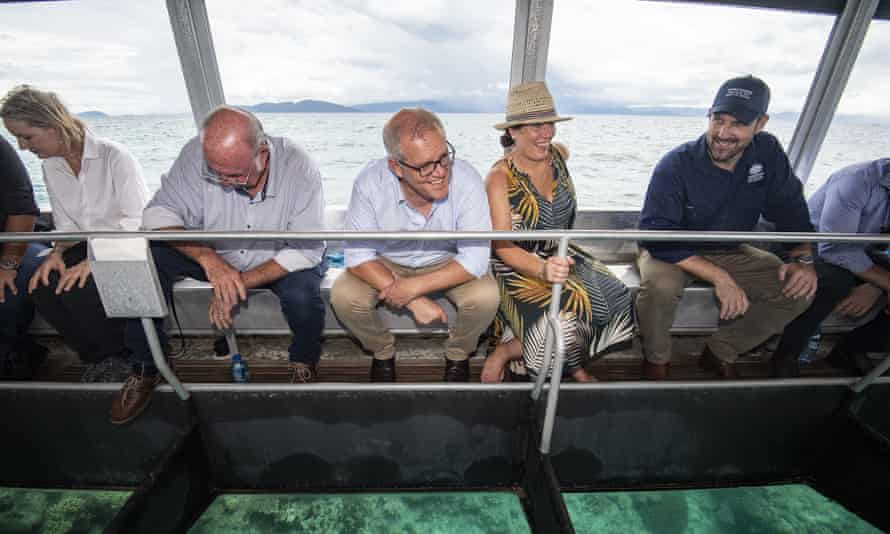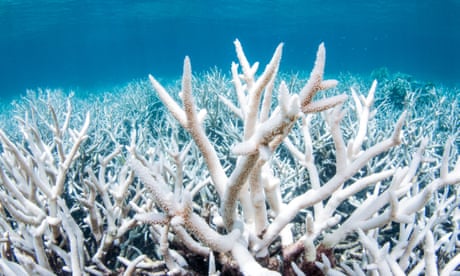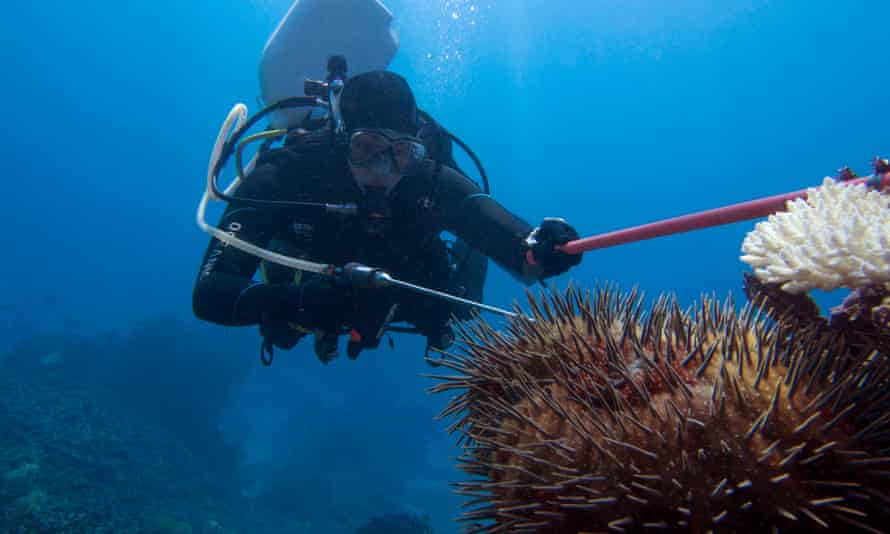Extract from The Guardian
Another $1bn has been committed, the latest of many funding pledges. But the reef’s biggest threat – global heating – overshadows everything.

Last modified on Sun 13 Feb 2022 06.01 AEDT
The Great Barrier Reef – the world’s largest coral reef system, covering an area about the size of Germany – always comes with big numbers.
Last month the Australian government pledged another seemingly large figure, $1bn, for conservation and science to be spent over the next nine years and spread along the 2,300km reef.
That comes on top of state and federal government commitments in the region of $3bn since 2014.
So where is all the money going, and will it be enough to keep one of the world’s most complex natural wonders from collapsing under the mounting pressure of global heating?

Without rapid global cuts to greenhouse gas emissions, many experts fear the $1bn will do little except delay the inevitable. More urgent for the Morrison government is whether the funding – contingent on the Coalition winning the next election – will convince the 21-country world heritage committee not to dump the reef onto its list of sites in danger when it meets in July.
The $1bn pledge came just days before a 1 February deadline to deliver a report to the world heritage centre in Paris outlining the health of the reef and what was being done to build its resilience.
An economic analysis of the value of the reef – released in 2017 but still referred to by the government – said the reef added $6.4bn to the nation’s economy in just one year, mostly through tourism, commercial fishing, recreation and scientific research.

The Great Barrier Reef – one of the world’s most complex natural wonders. Photograph: Jumbo Aerial Photography/AP
Water quality
Some $579.9m of the $1bn pledge would go to water quality projects, with the next largest slice – $252.9m – for reef management and conservation.
Another $92.7m is for research and adaptation and $74.4m would go to community- and traditional-owner led projects, such as habitat restoration and species protection.
The reef’s major threat is from climate change – specifically, rising ocean temperatures that have caused corals to bleach en masse five times since the first recognised outbreak in 1998.
Unesco’s science advisers want management plans to account for the effects of climate change, to have greenhouse gas emissions targets consistent with 1.5C of global warming (analysts say Australia’s approach is aligned with heating closer to 3C) and to do more to cut pollution running into the reef from the land.
Sediments, nutrients and pesticides running into the marine park can harm inshore corals, as well as marine habitats such as seagrass meadows and mangroves.
One key source for these pollutants is agriculture, both directly when on-farm pollutants get washed into waterways and indirectly when exposed soils and eroded riverbanks are washed away by rain.
According to the Queensland government, in the five years from 2017 to 2022, commitments focused on improving water quality stood at $270m from the state government and $396m from the commonwealth.
A spokesman for the environment minister, Sussan Ley, said under the $1bn plan, funding for water quality would rise from $60m a year now to $85m a year from 2026-27 through to the end of the decade.
The state and federal governments have set targets for water quality up to 2025, and release an annual report card. The most recent results with data up to 2019 show slow progress from previous years, even though three of the four key measures indicate the target is at least halfway to being met.
“Overall inshore marine condition remained poor in 2018-2019, with coral and seagrass in poor condition and water quality rated moderate,” the report said.
A spokesman for Ley said: “We are confident that the additional programs generated through this funding will significantly accelerate these outcomes.”
Queensland’s minister for the Great Barrier Reef, Meaghan Scanlon, says the $270m in recent years does not include a $2bn renewable energy fund, or $500m for land restoration.
“Since 2015, we’ve banned the dumping of dredge spoil, passed tree clearing laws, committed to bring in reef regulations, brought in net free zones and invested billions of dollars to help protect the Great Barrier Reef,” Scanlon says.

Prime minister Scott Morrison on a glass bottom boat during a visit to the Great Barrier Reef. Photograph: Brian Cassey/AAP
Direct intervention
Funding for direct interventions to improve water quality is spread across multiple projects. Between 2018 and 2023 some $200m of federal cash is routed through the Great Barrier Reef Foundation (GBRF) – a small not-for-profit that was given a $443m grant by the Turnbull government in 2018, to be spent over six years.
Theresa Fyffe, executive director of projects and partnerships at the foundation, said the bulk of the money had gone to 10 regional programs.
Fyffe said the foundation is working with more than 1,000 farmers across 15,000 sq km.
There are two approaches, she said. One is to improve the way farmers use fertilisers and pesticides so that less washes away during rain. Field officers work with farmers to map out their land and soil types and document how they use fertilisers and chemicals before drawing up management and monitoring plans.
The other identifies projects such as earthworks that will directly tackle problems such as erosion of creek-banks or damage to wetlands.
“You’re trying to drive enduring change,” she said. “Working with a grower for five years gives you a change that is there forever. That’s when farmers can become advocates.”
The grant to the foundation remains controversial. Labor said last month it would terminate the agreement and reallocate any unspent funds if it won the next election.
But there is unlikely to be much uncommitted cash left.

The foundation’s managing director, Anna Marsden, said by the end of this financial year, only $80m will be uncommitted and “every dollar is allocated for a program” with much of the uncommitted funds earmarked for traditional owner-led projects.
“We’re halfway through a job. And it’s a big job,” Marsden said.
“The reef is an extreme sport because there’s opposing views all over the place and everyone is passionate.
“But we can’t give up on the reef. The reef won’t give up and the public aren’t giving up and neither are the scientists. But this is the critical decade. It’s crunch time.”
The crown-of-thorns ‘plague’
In a landmark 2012 scientific paper, scientists at the Australian Institute of Marine Science found coral cover over the reef had dropped by half between 1985 and 2012. About 42% of that loss was down to the voracious coral-eating crown-of-thorns starfish (Cots).
“They are just so exquisitely evolved to take advantage of the conditions and they can get to plague proportions,” said Dr Roger Beeden, responsible for co-ordinating the Cots control program and director of reef interventions at the Great Barrier Reef Marine Park Authority.
Beedon said Cots are part of the reef’s ecosystem, but they have become a pest that are able to eat their own bodyweight in coral in a matter of days.
“They can cause very rapid decline in coral cover. There can be carpets of them.”
The bulk of the funding for the Cots program goes to running five dedicated boats with teams of up to eight divers that select locations based on new methods of modelling outbreaks.

Crown-of-thorns starfish monitoring in the Capricorn and Bunker groups on the Great Barrier reef. Photograph: Daniel Schultz/Great Barrier Reef Marine Park Authority
Divers use spear-like injection guns to pump the starfish – which can grow to the size of a dinner plate – with either ox bile or household vinegar. A new “one shot” method has replaced an older approach that used acid salt that needed to be injected into every arm of the starfish (miss one arm, and the starfish could survive).
Beeden said many tourism operators like to carry out their own culling operations as they visit reefs “so we provide them the materials to do that”.
The aim for the dive teams, Beeden said, is not to eradicate the starfish, but to get them down to sustainable levels. Divers have become highly skilled, he said, and can spot juvenile starfish the size of a thumbnail.
The reef is in the middle of the fourth major outbreak of the starfish since the first in the 1960s. Through the grant to the GBRF, $57m went to controlling Cots, and Beeden said about $41m was spent on the direct control program.
Under the latest federal government funding pledge, Beeden said $162m is identified for Cots control.
“Every adult coral we keep alive matters,” he said.
‘Shuffling the deckchairs’
Some $100m of the GBRF’s grant has gone to research and development projects, adding to funding of reef-related research at other institutions including CSIRO and the Australian Institute of Marine Science.
These R&D projects include the development of more heat-tolerant corals, methods to help the dispersal of coral larvae and more controversial approaches such as brightening clouds to shade corals undergoing heat stress.
A study released last year suggested if these mostly unproven methods could be deployed at scale, they could slow down the loss of corals by as much as two decades.
But scientists agree that any benefits the reef could gain from improving water quality or making corals more resilient will be swamped by rising ocean heat – an inevitable consequence of increasing levels of greenhouse gases in the atmosphere.
Two academic experts on reef management and science said the $1bn funding was “nonsensical” because it failed to address the direct cause of the majority of the reef’s problems.
“Unless we deal with climate change, everything else is just shuffling the deckchairs,” says Prof Terry Hughes, a prominent coral and reef scientist at James Cook University.
“Even if we had pristine water quality and we could find a magical bullet to control crown of thorns, we still have the overwhelming problem of global warming.
“These other Band-Aids will only make a difference if we deal with climate change. They’re all contingent on water temperatures being tolerable for corals.”
No comments:
Post a Comment